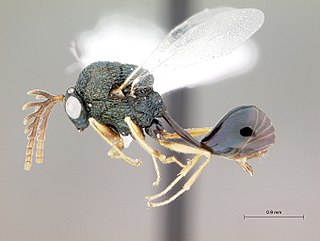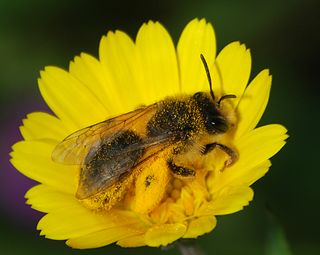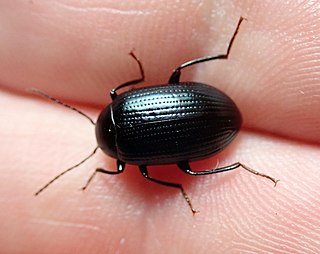
The Palearctic or Palaearctic is the largest of the eight biogeographic realms of the Earth. It stretches across all of Eurasia north of the foothills of the Himalayas, and North Africa.

Chalcid wasps are insects within the superfamily Chalcidoidea, part of the order Hymenoptera. The superfamily contains some 22,500 known species, and an estimated total diversity of more than 500,000 species, meaning the vast majority have yet to be discovered and described. The name "chalcid" is often confused with the name "chalcidid", though the latter refers strictly to one constituent family, the Chalcididae, rather than the superfamily as a whole; accordingly, most recent publications (e.g.,) use the name "chalcidoid" when referring to members of the superfamily.

In evolutionary ecology, a parasitoid is an organism that lives in close association with its host at the host's expense, eventually resulting in the death of the host. Parasitoidism is one of six major evolutionary strategies within parasitism, distinguished by the fatal prognosis for the host, which makes the strategy close to predation.

The Tachinidae are a large and variable family of true flies within the insect order Diptera, with more than 8,200 known species and many more to be discovered. Over 1,300 species have been described in North America alone. Insects in this family commonly are called tachinid flies or simply tachinids. As far as is known, they all are protelean parasitoids, or occasionally parasites, of arthropods, usually other insects. The family is known from many habitats in all zoogeographical regions and is especially diverse in South America.

Sawflies are the insects of the suborder Symphyta within the order Hymenoptera, alongside ants, bees, and wasps. The common name comes from the saw-like appearance of the ovipositor, which the females use to cut into the plants where they lay their eggs. The name is associated especially with the Tenthredinoidea, by far the largest superfamily in the suborder, with about 7,000 known species; in the entire suborder, there are 8,000 described species in more than 800 genera. Symphyta is paraphyletic, consisting of several basal groups within the order Hymenoptera, each one rooted inside the previous group, ending with the Apocrita which are not sawflies.

The Ichneumonidae, also known as the ichneumon wasps, Darwin wasps, or ichneumonids, are a family of parasitoid wasps of the insect order Hymenoptera. They are one of the most diverse groups within the Hymenoptera with roughly 25,000 species currently described. However, this likely represents less than a quarter of their true richness as reliable estimates are lacking, along with much of the most basic knowledge about their ecology, distribution, and evolution. It is estimated that there are more species in this family than there are species of birds and mammals combined. Ichneumonid wasps, with very few exceptions, attack the immature stages of holometabolous insects and spiders, eventually killing their hosts. They thus fulfill an important role as regulators of insect populations, both in natural and semi-natural systems, making them promising agents for biological control.

The Braconidae are a family of parasitoid wasps. After the closely related Ichneumonidae, braconids make up the second-largest family in the order Hymenoptera, with about 17,000 recognized species and many thousands more undescribed. One analysis estimated a total between 30,000 and 50,000, and another provided a narrower estimate between 42,000 and 43,000 species.

The Mymaridae, commonly known as fairyflies or fairy wasps, are a family of chalcidoid wasps found in temperate and tropical regions throughout the world. The family contains around 100 genera with 1,400 species.

Aprostocetus is a genus of hymenopteran insects of the family Eulophidae. The genus was erected by John O. Westwood in 1833. This very large group of parasitoid wasps has a global distribution.

Parasitoid wasps are a large group of hymenopteran superfamilies, with all but the wood wasps (Orussoidea) being in the wasp-waisted Apocrita. As parasitoids, they lay their eggs on or in the bodies of other arthropods, sooner or later causing the death of these hosts. Different species specialise in hosts from different insect orders, most often Lepidoptera, though some select beetles, flies, or bugs; the spider wasps (Pompilidae) exclusively attack spiders. More rarely, parasitoid wasps may use plant seeds as hosts, such as Torymus druparum.

The Orussidae or the parasitic wood wasps represent a small family of sawflies ("Symphyta"). Currently, about 93 extant and four fossil species are known. They take a key position in phylogenetic analyses of Hymenoptera, because they form the sister taxon of the megadiverse apocritan wasps, and the common ancestor of Orussidae + Apocrita evolved parasitism for the first time in course of the evolution of the Hymenoptera. They are also the only sawflies with carnivorous larvae.

A planidium is a specialized form of insect larva seen in the first-instar of a few families of insects that have parasitoidal ways of life. They are usually flattened, highly sclerotized (hardened), and quite mobile. The function of the planidial stage is to find a host on which the later larval instars may feed, generally until the insect pupates.

The Eucharitidae are a family of parasitic wasps. Eucharitid wasps are members of the superfamily Chalcidoidea and consist of three subfamilies: Oraseminae, Eucharitinae, and Gollumiellinae. Most of the 55 genera and 417 species of Eucharitidae are members of the subfamilies Oraseminae and Eucharitinae, and are found in tropical regions of the world.

The Perilampidae are a small family within the Chalcidoidea, composed mostly of hyperparasitoids. The family is closely related to the Eucharitidae, Chrysolampidae, and Eutrichosomatidae. As presently defined, six genera are described worldwide. They are often brilliantly metallic, with robust mesosomae and a small, triangular metasomae. They are generally very strongly sculptured. The prothorax is typically very broad and disc-like, and the labrum is multidigitate, a feature shared with the Eucharitidae.

The Tetracampidae are a small family of parasitic wasps in the superfamily Chalcidoidea. They are parasitoids of phytophagous insects, primarily flies. The 44 species in 15 genera are almost entirely absent from the New World.

Andrena is a genus of bees in the family Andrenidae. With over 1,500 species, it is one of the largest genera of animals. It is a strongly monophyletic group that is difficult to split into more manageable divisions; currently, Andrena is organized into 104 subgenera. It is nearly worldwide in distribution, with the notable exceptions of Oceania and South America. Bees in this genus are commonly known as mining bees due to their ground-nesting lifestyle.

The Ibaliidae are a small family of hymenopteran superfamily Cynipoidea. Ibaliidae differ from most of the cynipoids by the larvae being parasitoids on other wasp larvae in the group Siricidae. The Ibaliidae comprise three extant genera of fairly large wasps, with a total of 20 species, and is a sister group to the rest of the cynipoids except the small subfamily Austrocynipidae.
Anaphes nitens is a species of fairyfly, a chalcid wasp in the family Mymaridae. Native to Australia, it is an egg parasitoid of the gum tree snout beetle, a pest of Eucalyptus trees, and has been used in biological pest control of that species.

Ibalia leucospoides, the knife-shaped ibalia, is a species of ibaliid wasp in the family Ibaliidae.

Amarygmini is a tribe of darkling beetles in the family Tenebrionidae. There are more than 80 genera in Amarygmini.


















